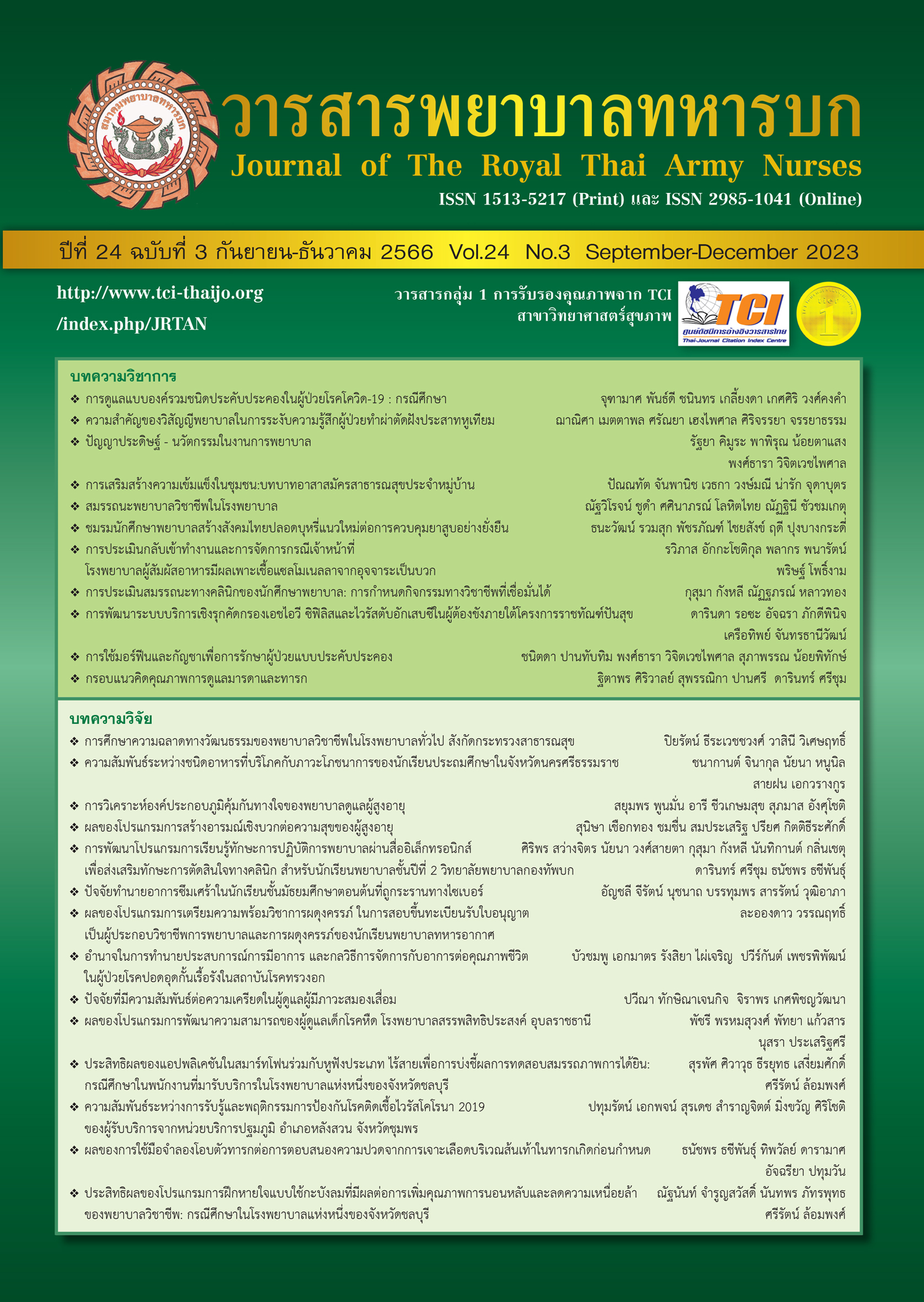Effects of Simulated Hands on Pain Responses to Heel Stick in Premature Infants
Keywords:
Simulated Hands, Pain Responses, Heel Stick, Premature InfantsAbstract
This quasi-experimental research with a cross-over design investigated the effects of simulated hands on responses to pain, heart rates and oxygen saturation in premature infants. The study examines behavioral and physiological responses to pain of 30 premature infants admitted in the Neonatal Intensive Care Unit. The subjects were recruited based on specified inclusion criteria and randomly assigned in order of treatment to both experimental and controlled conditions. In the experimental condition, each infant received simulated hands embracing. The videos were recorded throughout the process. The Neonatal Infants Pain Scale (NIPS) was used to assess the pain score. The repeated measures ANOVA was used to analyze. The results showed that the infants who received the simulated hands had the mean pain scores during and after the heel stick of the 1st, 3rd, 5th, 7th, and 10th minutes at 2.50, 1.23, 0.43, 0.17, 0.10, and 0 respectively. Moreover, the mean heart rates after the heel stick were 150.83, 145.07, 141.70, 137.97, 135.87, and 134.37 at the 1st, 3rd, 5th, 7th, and 10th minutes which were less than the infants who received routine nursing care. The mean blood oxygen saturation during and after the heel stick at the 1st, 3rd, and 7th minute was greater than those who receive routine nursing care. Therefore, the simulated hand should be used in nursing practice to alleviate pain from heel stick in preterm infants.
Downloads
References
Chang HH, Larson J, Blencowe H, Spong CY, Howson CP, Cairns-Smith S, et al. Preventing preterm births: analysis of trends and potential reductions with interventions in 39 countries with very high human development index. Lancet. 2013;381(9862):223-34.
Williams MD, Lascelles BDX.Early neonatal pain-a review of clinical and experimental implications on painful conditions later in life. Frontiers in Pediatrics. 2020; 8:30-47.
Johnston C, Barrington KJ, Taddio A, Carbajal R, Filion F. Pain in Canadian NICUs: have we improved over the past 12 years? The Clinical Journal of Pain. 2011;27(3):225-32.
Owens ME, Todt EH. Pain in infancy: neonatal reaction to a heel lance. Pain. 1984;20(1):77-86.
Bellieni CV. Pain assessment in human fetus and infants. American Assosiation of Pharmaceutical Scientists. 2012;14(3):456-61.
Peterson BS, Anderson AW, Ehrenkranz R, Staib LH, Tageldin M, Colson E, et al. Regional brain volumes and their later neurodevelopmental correlates in term and preterm infants. Pediatrics. 2003;111(5):939-48.
Burnett AC, Cheong JLY, Doyle LW. Biological and social influences on the neurodevelopmental outcomes of preterm Infants. Clin Perinatol. 2018;45(3):485-500.
Mangat AK, Oei JL, Chen K, Quah-Smith I, Schmolzer GM. A review of non-pharmacological treatments for pain management in newborn infants. Children-Basel. 2018;5(10):1-12.
Tassaneeyarat S, Deoisres W, Chaimongkol N. Factors affecting nurses’ pain management practice in neonatal intensive care units. Journal of The Royal Thai Army Nurses. 2022; 23(2):330-8. (in Thai).
Clarke SP, Cheung RB. The nurse shortage: Where we stand and where we’re headed. Nursing Management. 2008;39(3):22-7.
Hartley KA, Miller CS, Gephart SM. Facilitated tucking to reduce pain in neonates: evidence for best practice. Advances in Neonatal Care. 2015;15(3):201-8.
Corff KE, Seideman R, Venkataraman PS, Lutes L, Yates B. Facilitated tucking: a nonpharmacologic comfort measure for pain in preterm neonates. Journal of Obstetric, Gynecologic & Neonatal Nursing. 1995;24(2): 143-7.
Liaw J-J, Yang L, Katherine Wang K-W, Chen C-M, Chang Y-C, Yin T. Non-nutritive sucking and facilitated tucking relieve preterm infant pain during heel-stick procedures: A prospective, randomised controlled crossover trial. International Journal of Nursing Studies. 2012;49(3):300-9.
Sundaram B, Shrivastava S, Pandian JS, Singh VP. Facilitated tucking on pain in pre-term newborns during neonatal intensive care: a single blinded randomized controlled cross-over pilot trial. Journal of Pediatric Rehabilitation Medicine. 2013;6(1):19-27.
Cignacco E, Axelin A, Stoffel L, Sellam G, Anand K, Engberg S. Facilitated tucking as a non-pharmacological intervention for neonatal pain relief: is it clinically feasible? Acta Paediatrica Journal. 2010;99(12):1763-5.
Salmani N, Karjo Z, Dhghani K, Sadeghnia A. Effect of facilitated tucking with the nurse and a simulated hand on physiological pain index during vein puncture on premature infants. Journal of Babol University of Medical Sciences. 2018;20(9):14-9.
Melzack R, Wall PD. Pain mechanisms: a new theory. Science. 1965;150(3699):971-9.
Basbaum AI, Fields HL. Endogenous pain control mechanisms: review and hypothesis. Annals of Neurology. 1978;4(5):451-62.
Jongudomkarn D. Pain in children; holistic family- centered nursing. Khon Kaen; Siriphan Offset; 2003. (inThai).
Bujang MA. A Step-by-Step process on sample size determination for medical research. Malaysian Journal of Medical Sciences. 2021;28(2):15-27.
Lawrence J, Alcock D, McGrath P, Kay J, Mac Murray SB, Dulberg C. The development of a tool to assess neonatal pain. Neonatal network: NN. 1993;12(6):59-66.
Supapong S. Effects of soothing and supporting program on heart rate, oxygen saturation and pain among neonates undergoing venipuncture. [thesis]. Khon Kaen: Khon Kean University; 2001. (in Thai).
Simons SHP, Tibboel D. Pain perception development and maturation. Seminars in Fetal and Neonatal Medicine. 2006;11(4): 227-31.
Thaobun P, Daramas T, Kongsaktraku C. Effect of facilitated tucking on pain responses to heel stick in premature infants. Ramathibodi Nursing Journal, 2020; 26(1): 18-30. (in Thai).
Gordan R, Gwathmey JK, Xie LH. Autonomic and endocrine control of cardiovascular function. World Journal of Cardiology. 2015;7(4):204-14.
Downloads
Published
How to Cite
Issue
Section
License
Copyright (c) 2023 Journal of The Royal Thai Army Nurses

This work is licensed under a Creative Commons Attribution-NonCommercial-NoDerivatives 4.0 International License.
บทความหรือข้อคิดเห็นใดใดที่ปรากฏในวารสารพยาบาลทหารบกเป็นวรรณกรรมของผู้เขียน ซึ่งบรรณาธิการหรือสมาคมพยาบาลทหารบก ไม่จำเป็นต้องเห็นด้วย
บทความที่ได้รับการตีพิมพ์เป็นลิขสิทธิ์ของวารสารพยาบาลทหารบก
The ideas and opinions expressed in the Journal of The Royal Thai Army Nurses are those of the authors and not necessarily those
of the editor or Royal Thai Army Nurses Association.






